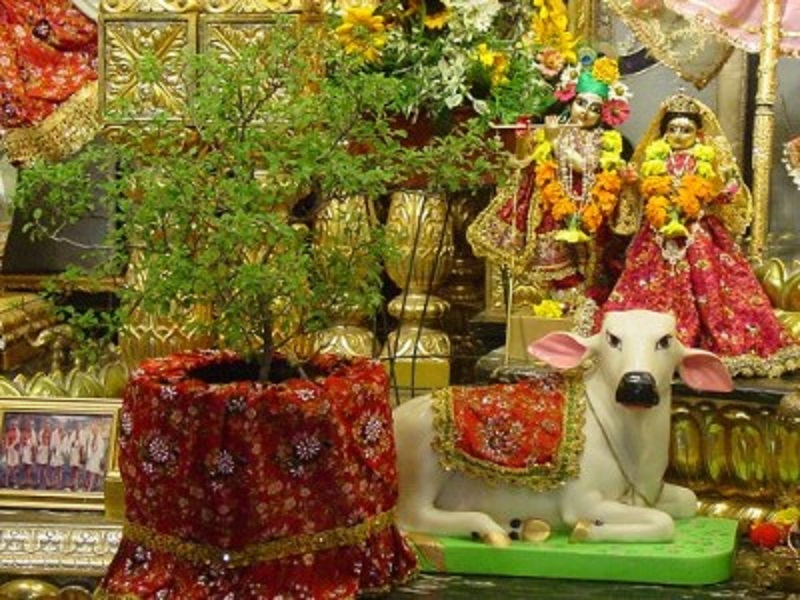India’s Holy Basil – Tulsi

The Tulsi plant is venerated and is invariably grown in the courtyard of every Hindu house. It is known as Holy Basil in English and Tulasi in Sanskrit. Other names used for the Tulsi are Manjari, Krishna Tulsi, Trittavu, Tulshi, and Thulsi.
Tulsi is a goddess in the form of a plant bestowed with great spiritual and healing powers. According to legend, no amount of gold could outweigh Krishna, but a single Tulsi leaf placed on the pan in loving devotion tilted the scale.
To inaugurate the winter wedding season in many parts of India, Tulsi, as a plant, is ceremonially married to Krishna in the form of a sacred stone.
Suggested Read: Advantages And The Importance Of Tulsi
Tulsi has got a great medicinal value.
1. The earth around the Tulasi Plant is used as an application in the form of a paste for massaging the body to counteract the effects on the skin of the debilitating marshy environment. Famous Indian wrestlers have used it to come out victorious.
2. Tulasi leaves placed with water in a shining copper vessel overnight and partaken in the morning, activates a student’s brain and increase concentration and memory.
3. Tulasi is used by Indian physicians in the treatment of mental weakness, such as loss of confusion, depression, melancholia, hysteria, migraine, headache, and cerebral congestion, etc.
4. Tulasi leaves, eaten as a daily routine in the marshy area, make one immune to fever. A few fresh leaves of Tulasi chewed and eaten with very little pepper, daily in the morning, on the empty stomach prevents malaria and helps to cure it.
5. Tulasi is employed by Ayurvedic and traditional gynecologists in regulating the menstrual cycle in women. It is used to improve fertility both in the barren and in those who are unable to safely reach full term. At the commencement of the postpartum, it helps to regularize the lochia.
6. Tulasi is used to purify blood in blood poisoning and similar conditions, along with the juice of neem leaves.
7. As a common household remedy, it is found very effective in common household remedy. It is found very effective in the common cold, laryngitis, tonsillitis, cough, influenza, and its complications.
8. In bronchial asthma and respiratory allergic conditions, a pinch of pure turmeric powder mixed with honey and the juice of Tulasi is very effective.
9. It is used externally and internally in relieving discomfort and pain associated with dental decay such as caries and chronic infective conditions such as pyorrhea.
10. In alimentary disorders causing gastritis, flatulence, colic, and dyspepsia, Tulasi is very useful to stimulate digestive secretions.
11. Seasonal arthritis triggered by humid weather is relieved by this remedy.
12. In pneumonia, physicians use it as Anupama for specific remedies. In the preparation of Tribhuvanakirti Rasa; a classical Ayurvedic remedy that protects the lungs and clears congestion in the later stages of influenza, Tulasi is one of the juices used in herbally activating the preparation.
13. Regular use of Tulasi prevents pleurisy and also supports specific curative remedies used to treat the same.
14. Externally and internally, it is useful in palliating eye symptoms caused by conjunctivitides such as redness, lachrymation, adhesive secretions, and photophobia.
15. Tulasi cures dimness of sight. Its juice, regularly used as eye drops, prevents cataract formation. Here it is as efficient as the homeopathic remedy, Cineraria maritime.
16. It is very useful in itching and irritation of the ear and difficulty of hearing caused by
Vatakapha. Samsarga Dosha builds up as age advances.
17. Tulasi gives a glow to the skin when constantly used both internally and externally. It
is a freely available cosmetic for women.
18. Fresh juice of the plant, steeped in honey, is a great pediatric remedy for cold and cough in children. Being mildly laxative, it also helps eliminate the tract of the phlegm.
19. Partaken with ginger juice after meals, Tulasi acts as a carminative and digestant.
Suggested Read: Tulsi Chalisa
Suggested Read: Tulsi Vivaah Puja






